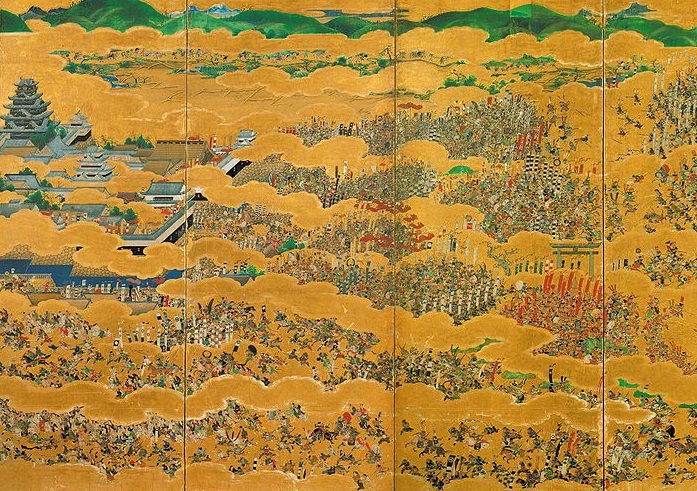
Story Highlights
- Historical event:
- 04 June 1615
- Forces under Shogun Tokugawa Ieyasu took Osaka Castle in Japan, beginning a period of peace which lasted nearly 250 years.
The rise of Tokugawa Ieyasu
After the death of the powerful daimyo (a position similar to a high-ranking noble in Europe) Toyotomi Hideyoshi in 1598, Japan was governed by the Council of Five Regents, the most prominent of whom was Tokugawa Ieyasu.
Within only around two years, Ieyasu utterly defeated his enemies at the Battle of Sekigahara, seized control of Japan for himself and abolished the Council. In 1603 he established the Tokugawa shogunate (a sort of military dictatorship, with the Emperor being a mere figurehead), which he ruled from his capital at Edo.
Although he officially retired in 1605 and passed the title of shogun to his son, Ieyasu continued to rule behind his back. Ieyasu sought to establish a powerful centralized regime which would bring long-lasting peace and prosperity to the country.
His only remaining rivals were the Toyotomi clan, led by Hideyoshi’s young son, Hideyori. The center of their power was located at Osaka, the castle Toyotomi Hideyoshi had erected as a monument to his power and the most heavily-defended fortress in Japan.
It is interesting that Ieyasu actually gave his granddaughter’s hand in marriage to the young Hideyori. After all, he bore the Toyotomi name, and the union of the two rival clans could have done much to reduce the tensions between the Tokugawa clan and the various disaffected elements of Japanese society.
Ieyasu’s own son, Hidedata, showed himself as a mediocre leader during Sekigahara, which left doubts about his performance after Ieyasu’s death.
However, Hideyori grew up to be a gifted and intelligent young man, albeit naive. Namely, “uncle” Ieyasu began to see him as a threat that needs to be eliminated before he can develop further. Ieyasu was well-known for his lack of scruples, but it seems Hideyori ignored his past actions.
Ieyasu first tried to encourage Hideyori to bankrupt himself through monumental building projects, but this came to naught because the young man’s resources seemed bottomless.
He then turned to making ridiculous charges that the inscriptions on Hideyori’s great bronze bell (which Hideyori had built for a Buddhist Temple at Daibutsu) are insulting to the Tokugawa clan.
Next, he tried to get Hideyori to leave Osaka Castle. However, the young man still hoped for an accomodation with his old “uncle”, and it seems he had no ambitions to rule Japan. Nonetheless, he was not prepared to leave his family castle.
It was now obvious even to Hideyori that there would be no reconcilliation. The following conflict had two phases, the Winter Campaign (1614) and the Summer Campaign (1615).
Winter campaign
In 1614 the Toyotomi clan rebuilt Osaka castle and prepared for war against the Tokugawa shogunate, gathering a force of ronin (masterless samurai) and other enemies of the shogunate.
Few daimyos answered Hideyori’s calls for support, however – silent testimony to Ieyasu’s terrible reputation. In total, Hideyori gathered some 90,000 troops. Interestingly, a relatively large number of them were Christians.
Ieyasu decided to prevent this force from growing any further, and led some 164,000 ment to Osaka. The first minor battles began on 19 November, while the siege on Osaka Castle itself began on 4 December.
What followed was a grueling siege, where the Shogun’s armies were repeatedly repelled by the castle’s powerful defenses and determined defenders. Ieyasu then resorted to artillery (including cannons imported from Europe) and sappers to dig under the walls, but was still not able to make significant headway.
However, some of the defenders began to urge Hideyori to negotiate, and he eventually agreed. The siege ended on 22 January, after a truce was agreed on and Toyotomi Hideyori pledged not to rise in rebellion. The castles’ outer defenses were considerably weakened through trickery despite Hideyori’s protests.
Summer campaign
However, in spring 1615, Ieyasu discovered that Hideyori was amassing even more troops, and rebuilding the castle’s defenses. Toyotomi’s forces began to attack the Shogun’s forces near Osaka.
On 26 May Osaka forces engaged the Shogun’s allies at the Battle of Kashii, but were defeated. Several other battles followed, culminating with the Battle of Tennoji.
Hideyori’s army under Sanada Yukimura tried to encircle the enemy army, while Ieyasu’s army (led by the Shogun’s son, Tokugawa Hidetada) deployed in four parallel lines, prepared to make flanking maneuvers. Interestingly, both sides ended up making a mess of their plans.
A confused melee followed, but Hideyori’s army was eventually broken after Yukimura was killed. A smaller force led by Hideyori himself tried to sally from the castle in order to aid Yukimura’s faltering troops, but they were too late, and were promptly chased back into the castle.
They had no time to set up a proper defense of the castle, and the attackers set it ablaze and bombarded it with their heavy artillery. Seeing the situation is hopeless, Hideyori committed seppuku (ritual suicide), thus ending the last major resistance against the Tokugawa shogunate.
Interestingly, some records about the battle mention the legendary sword-master Miyamoto Musashi as a participant in the battle, but there are no records of his actual accomplishments in the battle.
Consequences
The shogun’s troops delivered the heads of Hideyori’s officers to Ieyasu as trophies. They also captured Hideyori’s eight-year-old son and mercilessly beheaded him, even though he was Ieyasu’s grandson. Surprisingly, the boy was supposedly defiant to the end.
Hideyoshi’s grave was destroyed, and there are records of pillaging and mass rapes by the shogun’s forces towards the end of the siege. Only Hideyori’s daughter Naahime was spared, and she later became a nun at Kamakura’s Tokei-ji (a Buddhist temple and former nunnery).
Osaka Castle was repaired and given to Matasudaira Tadayoshi. The Toyotomi clan was disbanded.
The end of the siege marked the end of the Sengoku Jidai (“Age of the Country at War”) period. The shogunate would survive unchallenged for over 250 years.
New laws were enacted, greatly restricting the number of castles which can be owned by a single clan. In fact, many “excess” castles were destroyed due to these laws.
Tokugawa Ieyasu himself suffered several wounds during the campaign, which took a severe toll on his health.
He died only one year later, on 1 June 1616, leaving his descendants the rulers of a united Japan. Thus he is today remembered as the last of the “three great unifiers” of Japan.




